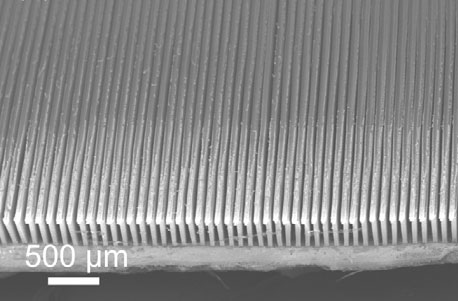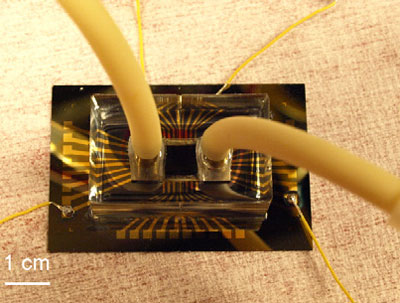| Posted: Jan 13, 2012 | |
Cooling computer chips with interface-enhanced carbon nanotubes |
|
| (Nanowerk Spotlight) A couple of years back, one of our Nanowerk Spotlights addressed the issue of thermal management of computer chips – the fact that heat has become one of the most critical issues in computer and semiconductor design. There are three factors playing the most important role in a microscale heat sink cooling system: the thermal conductivity of the material of the cooling fins; the heat exchange area of the cooling fins; and the convection between cooling fins and ambient. Carbon nanotubes (CNTs) satisfy the first two factors very well. They possess very high thermal conductivity and very high surface/volume ratio among other outstanding physical properties such as light, high current carrying capacity, excellent mechanical strength, etc. | |
| To reduce high temperatures, today's heat sinks – finned devices made of conductive metal such as aluminum or copper – are attached to the back of the chips to pull thermal energy away from the microprocessor and transfer it into the surrounding air. Previously, researchers have shown ("Nanotechnology to the rescue of overheating computer chips") that fin structures made from CNTs can dissipate chip heat as effectively as copper – the best known, but most costly, material for thermal management applications. | |
| "Having these gains in cooling capability demonstrated, we have devised a design of directly fabricating carbon nanotube microfins onto chip surfaces to make microchannels for extremely high efficiency water-assisted cooling, thus integrating the benefits from both the microchannel structure and the high thermally conductive carbon nanotubes," Johan Liu, Professor and Head of the SMIT Center and Bionano Systems Laboratory at Chalmers University of Technology in Sweden, tells Nanowerk. | |
| Reporting their work in a recent edition of Nanotechnology ("A complete carbon-nanotube-based on-chip cooling solution with very high heat dissipation capacity"), Liu and his team demonstrate the application of their interface-enhanced CNTs as on-chip cooling fins in a microchannel heat sink. | |
 |
|
| CNT microfins transferred onto the test chip. (Image: Dr. Liu, Chalmers University of Technology) | |
| "In order to achieve good heat dissipation effect, we made use of water to generate a strong forced convection with carbon nanotube fins so that the third factor is also satisfied," explains Liu. "We presented a complete solution to realize this potential. The prototype, the carbon nanotube-based on-chip heat sink, demonstrated the ability to cool down hotspots with above 1000 W/cm2 in heat flux. Thus it could be used for thermal management of microsystems with very high power density." | |
| Previously, air has been used as coolant to cool down a electronic component with carbon nanotubes as cooling fins. However, the heat capacity of air is quite low and the carbon nanotube fins are exposed without protection, which could be a threat to the reliability of the system and could lead to potential environmental issues. Therefore, Liu's team proposed a totally new design to solve these problems. In addition, they wanted to take advantage of the very high thermal conductivity as well as the extremely large surface volume ratio of the carbon nanotubes compared to any cooling fins available. | |
| To fabricate their CNT heat sink, the researchers first defined the microfin structures by standard photolithography and lift-off processes. They then applied a specially developed CNT transfer technique to position the microfins at the desired position on the chip. Finally, a plastic lid was covered on the top of the CNT microfins to create microchannels through which the coolant could flow. | |
 |
|
| PDMS-packaged CNT microfin on-chip cooling system connected with coolant source and power source. CNT microfins are still visible after packaging. (Image: Dr. Liu, Chalmers University of Technology) | |
| Liu notes that, compared with the traditional forced air convection cooling method which can achieve 50 W/cm2 cooling capability, the team's CNT microfin on-chip cooling scheme has demonstrated the ability to handle a heat flux as high as 5000 W/cm2, and this can be even higher with thicker CNT microfins and higher water velocity. | |
| "Benefiting from the metal-enhanced CNT interface, the excellent thermal performance and the huge surface/volume ratio of CNTs, our water-assisted CNT microfin on-chip cooling solution exhibits a great capability of cooling down very high power density electric components, and is possible to meet the requirement for managing the thermal budget of the hottest electronic systems to date," he says. | |
| Beyond the design of the on-chip heat sink, the carbon nanotube transfer technique the researchers developed for fabricating their prototype could also find wide applications in the field of electronics because it removes a number of obstacles hindering the applications of carbon nanotubes, such as high growth temperature of carbon nanotubes, weak interaction between carbon nanotubes and substrates, huge contact resistance between carbon nanotubes and substrates, etc. | |
 By
Michael
Berger
– Michael is author of three books by the Royal Society of Chemistry:
Nano-Society: Pushing the Boundaries of Technology,
Nanotechnology: The Future is Tiny, and
Nanoengineering: The Skills and Tools Making Technology Invisible
Copyright ©
Nanowerk LLC
By
Michael
Berger
– Michael is author of three books by the Royal Society of Chemistry:
Nano-Society: Pushing the Boundaries of Technology,
Nanotechnology: The Future is Tiny, and
Nanoengineering: The Skills and Tools Making Technology Invisible
Copyright ©
Nanowerk LLC
|
|
|
Become a Spotlight guest author! Join our large and growing group of guest contributors. Have you just published a scientific paper or have other exciting developments to share with the nanotechnology community? Here is how to publish on nanowerk.com. |
|
